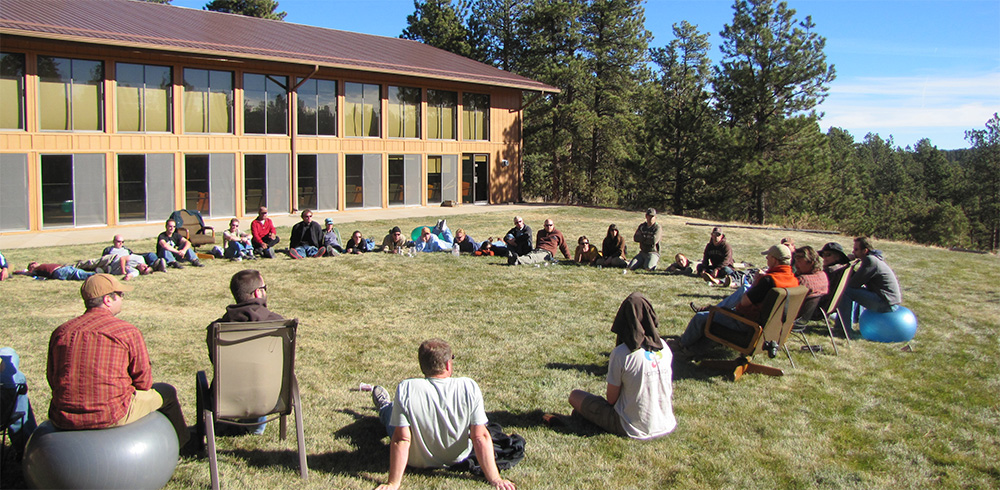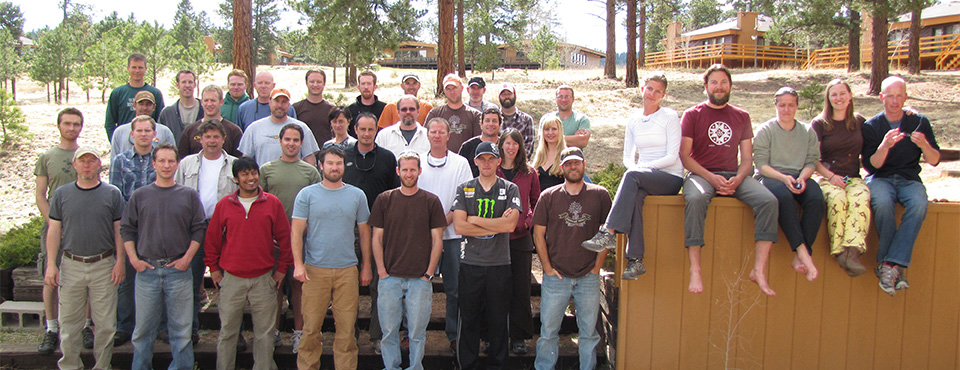Publish Date: April 2nd, 2019
The story of Namaste Solar has been written by many individuals over the past 14 years, and while we can’t cover every chapter of this history, we can offer pieces of the Namaste Story from the perspective of a group of individuals. Part three covers some major shifts at our company from 2008 to 2012. Read more of our story with parts one, two, four, and five. (Photo of Namaste Solar company retreat, May 2008)
The first few years at Namaste Solar were marked by the possibilities of a new company and a new industry as well as by the enthusiasm and connection shared by the first co-owners. They put their hearts into starting an employee-owned solar company to help transform energy and transform business. “We had this belief that we were fighting for a bigger mission with a unique, employee-owned, fully transparent company,” said Stephen Kane (employee #5 or 6, Co-Owner, and Director of Technical Services).
By 2008, the company was growing quickly and changing in ways that challenged the existing structure and the co-ownership involved. This year marked the start of some big shifts for the company that would set the course for how Namaste Solar looks today.
Challenges of Growth
In 2008, the co-owners were watching the recession hit, and major changes were happening to the local solar rebate programs, adding ongoing layers of uncertainty into the market. Boulder County was the second in the nation to implement a property assessed clean energy (PACE) financing program, and this program is part of what helped Namaste Solar bridge the recession years.
In fact, the company was still growing at a significant rate. The team in Boulder was moving into a new building, and the company’s second office opened in Denver in the summer of 2008. More people and the separate offices made the practices of transparency and democratic decision making more challenging. “For those of us who had been there in the early days where it was 20 people and we were doing daily big picture meetings, it was difficult to maintain the culture through that growth,” said Amanda Bybee (employee #5 or 6, past Co-Owner, and current CEO of Amicus O&M Cooperative).
An Offer on the Table
During the summer of 2008, the co-ownership was approached by a national solar company with an offer to buy, sparking the first big shift at Namaste Solar. “We had been growing like crazy for the last two years. We didn’t feel like we were growing intentionally, and it was burning people out. It was not sustainable,” said Amanda. “In 2008, these discussions were about what path do we want to take. Do we want to sell our company? Do we want to consider taking on private equity? Or do we want to slow this train down a little bit and take control of our own growth?”
There were about 40 co-owners at the time, and a straw poll at the beginning of the debates showed the vast majority of co-owners wanting to sell the company. After a series of mini-retreats and many debates, a few persuasive voices convinced the company that a new model could help finance the company in a more sustainable way. In the end, the decision to stay internally owned was almost unanimous.
New Governance Structure
After the vote not to sell, the co-ownership slowed down the company’s growth to be more intentional, and also started to explore alternative models of co-ownership. Up until that point everyone at the company was engaged in almost every decision, but that process was unsustainable and part of what was causing burnout. The co-ownership recognized that processes would have to change, and they would have to learn to delegate more decision making.
“That was a fundamental cultural shift, and it was really hard for a lot of us that had been there since the early days. We were so accustomed to being in the room every time a decision was made,” said Amanda. “You have to trust that your fellow co-owners are going to make good decision even if you’re not in the room. It was difficult to let go.”
From 2009 through 2010, the co-ownership researched new models of employee-ownership, finally connecting with Equal Exchange. They provided their cooperative model, equity structure, and bylaws and articles as an example for Namaste Solar to follow and were also part of the inspiration for Namaste Solar to become a Certified B Corp.
Namaste Solar then began the work to transition into a worker-owned cooperative where each co-owner held one share of equal value and held the power of one vote. “One of the major contentions as we converted to a cooperative was the strike price. What do we call a share for all the historical shares to be worth when we convert,” said Stephen. “In the end the conversion struck a more equitable structure and level set our responsibilities.”
 Namaste Solar recapitalization retreat discussions
Namaste Solar recapitalization retreat discussions
Even though Namaste Solar had utilized one vote per person for day-to-day decision making, more official votes (Board of Director seats, for example) had been done under the official one vote per share policy. This concentrated voting power in the hands of roughly 10 individuals who had been with the company the longest and had invested the most. “That was really at odds with the philosophy and values of the company, so the cooperative model of one share one vote felt like truing up the governance structure with the way we truly felt in our hearts,” said Amanda.
The new structure was voted on and approved in December 2010 and went into effect January 1st, 2011. That was the same month Namaste Solar passed the certification process to become a B Corp.
The 2011 Cliff
And then an email arrived from Xcel Energy notifying the Colorado solar industry that their rebate program, a significant driver of the solar industry at the time, would close after the next 3MW of applications in Colorado. No one knew how long the program would be closed or what it would look like when it reopened. Many feared that the program could be closed for as long as a year, like it had been in other states. “That threw the whole industry into chaos,” said Amanda. “All the sales people immediately got on the phone and called every single lead they had to say we have this little window. It took less than 24 hours for that 3 MW to be subscribed.”
Lobbying efforts were immediately underway to reopen the program and help redefine what the rebate program would look like, but the question of “how long” still loomed large. Namaste Solar was fortunately carrying a six-month installation backlog, providing some temporary insurance that many other companies in the market didn’t have, but the rebate uncertainty caused the next big shift at the company.
“In that chasm of shutdown until further notice, we don’t know how long the spicket would be off. So we started layoff deliberations,” said Stephen. “We had never even talked about how that would work.”
In the end, it was decided that Namaste Solar would lay off 12 individuals. The CEO recommended a list and the Board ratified the decision. “It was one of the few times that the Board went into a closed session, which was very controversial because transparency is such a pillar of the company,” said Amanda. “But the pledge was to be completely transparent afterwards. So that day we met with each person individually and the next day we had an all-hands meeting.”
This was a pivotal moment in Namaste Solar history because of how painful the layoffs were and because it broke a trust within the co-ownership. It reinforced that co-ownership didn’t ensure your job at the company and confronted the optimistic view that the co-ownership could make it through the toughest times unscathed. “The layoffs were a really tough decision, and there is still some healing that hasn’t happened,” said Stephen.
Growing Up as a Company
These years between 2008 and 2012 were intense and volatile with many big shifts in Namaste Solar company structure and culture. “We were growing up in that time as an organization,” said Amanda.
There were also many exciting first during these years. The company’s continued growth meant a move to a new, LEED Certified Building in Boulder, Namaste Solar started doing more commercial projects, and the team continued to expand its solar expertise. Namaste Solar installed the solar PV system on the new Colorado Convention Center, requiring innovative technical solutions, and installed the system on the Governor’s mansion. “It was an intense time, but I was also super proud to be part of it,” said Stephen. “There was a lot of pride in how we ran the business and treated our customers.”

 Namaste Solar company retreat, May 2011
Namaste Solar company retreat, May 2011